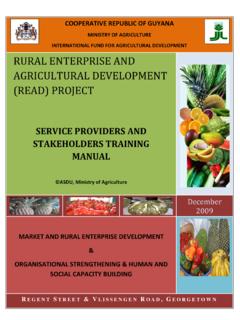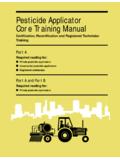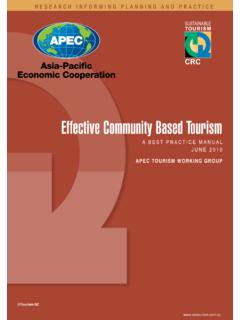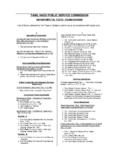Transcription of A MANUAL FOR TRAINERS - Home | Food and …
1 CommunicationOrganizationDevelopmentPart icipationTrainingLearningAppraisalMonito ringEvaluationUnderstandingcooperativesP lanningOrganizingManagementA MANUAL FOR TRAINERS A MANUAL FOR TRAINERS FOOD AND AGRICULTURE ORGANIZATION OF THE UNITED NATIONSRome, 1998 The designations employed and the presentation of material in thispublication do not imply the expression of any opinion whatsoeveron the part of the Food and Agriculture Organization of the UnitedNations concerning the legal status of any country, territory, city orarea or of its authorities, or concerning the delimitation of itsfrontiers or rights reserved. No part of this publication may be reproduced, stored in aretrieval system, or transmitted in any form or by any means, electronic, mechani-cal, photocopying or otherwise, without the prior permission of the copyrightowner. Applications for such permission, with a statement of the purpose andextent of the reproduction, should be addressed to the Director, InformationDivision, Food and Agriculture Organization of the United Nations,Viale delle Terme di Caracalla, 00100 Rome, Italy.
2 FAO 1998 Reprinted 2001 IndexIntroductionCurrent trends in the development of cooperative organisationsiAbout this manualiiObjectives of the manualiiStructure and approach of the manualiiiModule 1 Understanding cooperativesSection What is a Cooperative?3 Reference InfoSeven values and principles of cooperatives5 Conditions needed to create a cooperative6 Essential conditions for continued success of cooperative organisations6 Potential advantages of cooperative organisations7 The role of government and external assistance in promoting cooperative organisations8 Development of cooperatives from other self help organisations8 Section Forming a marketing cooperative9 Reference InfoForming and organising a marketing cooperative11 Main steps and activities in forming a cooperative11 Contents of the cooperative statutes/by-laws13 Organs of the cooperative15 Module 2 Participation training & learningSection Participation in cooperatives3 Reference InfoAbout participation, learning, training and action5 What does participation mean?
3 5A typology of participation in cooperative organisations6 Constraints of participation7 Key questions for assessing the level of participation in cooperatives7 Section Training in cooperatives8 Reference InfoThe need for training10 Requirements for the trainer10 Participatory learning11 Training content13 The role of the trainer15 Planning and organising training16 Participatory training techniques18 Reactions to participatory methods20 Visual aids22 Training with illiterate participants24 Module 2 AnnexExercises for Participatory TrainingA. Exercises for introduction and icebreaking25B. Methods of visualisation27C. Exercises to bring out the variety of ideas and opinions among participants/members31D. Exercises for enhancing group co-operation33E. Training evaluation exercises38 Seating arrangements41 Module 3 CommunicationSection Internal CommunicationIntroduction3 Reference InfoWhat is communication?6 Means of communication6 Communication problems7 Examples of conflicts8 Improving communications8 Promoting effective communication in cooperative organisations11 Conducting meetings12 Dealing with conflicts in training sessions14 Section External communicationsReference InfoThe relationship between cooperatives and governments18 Public Relations (PR) and the cooperative image19 Negotiations and contracts20 Module 3 AnnexCommunications exercises Exercises on communication in cooperative groupsControlled dialogue: Clear speaking - careful listeningWhispered message One look into the mirrorExercises to express wishes and needs of participantsRole plays on different leadership stylesA conflict in a groupRole plays on group conflictsThe pool (Time: 30 to 60 minutes) Public Relations ExercisesModule 4: Organisational DevelopmentIntroductionSection.
4 Organisational development and the vision statementReference InfoDefining organisational development5 Approaches to organisational development6 The cooperative vision8 Section : Norms, structures and entrepreneurshipReference InfoNorms and cooperative development14 The development of appropriate organisational structures15 Members representation in organisational development17 Leadership structure17 Structures to enhance management effectiveness19 Incentive development19 Cooperative group development21 Maintaining motivation within the cooperative group22 Cooperative enterprise development23 Training versus non-training solutions in Module 4: Tools and checklist for facilitating cooperativeorganisational developmentDetermining if there is there an organisational development problem at allInitial assessment of the cooperative s situationExample of structuring promotional activities using a work groupExamples of typical situations in which promoters/ TRAINERS are asked to advise on organisational developmentModule 5: Cooperative ManagementSection Managing the Cooperative GroupReference InfoDeveloping leadership6 Meeting members needs10 The free-rider effect11 Promotion of members economies13 Section : Managing the Cooperative EnterpriseReference InfoFinancial management17 Securing finance19 Loan finance21 Information on finances23 Personnel Management24 Performance rating and reward systems28 Section.
5 Management of services to support members productionReference InfoAgricultural service cooperatives32 Marketing33 The costs of marketing36 Keeping marketing costs low37 Determining prices and payments to members38 Supply Management40 Functions of a supply cooperative41 Storage of supplies and sales promotion43 Creditmanagement44 Controlling service performance46 Section : Diversification, growth and collaborationReference InfoBuilding partnerships from a position of strength51 Determining factors for cooperative change in market economies51 Opportunities for cooperatives in developing agricultural markets52 Optimum size for a primary cooperative52 Diversification53 Mergers53 Unions and federations54 Annex Module 5 Module 6: Tools for Planning and OrganisingCooperative ActivitiesSection : From visions to action plansReference InfoFrom visions to action plans6 Planning tools for strategic management8 The Logical Framework10 Strengths, Weaknesses, Opportunities and Threats: SWOT analysis17 Section : Planning relationships and assigning responsibilitiesReference InfoAssignments of responsibility - who does what?
6 22 Timing of activities - When to do what?23 Structural plans - Who reports to whom?23 Section Physical and economic planning: stock inventory,budgeting and reportingReference InfoInventory and stock planning27 Budgets and cash flows27 Operating, record keeping and financial management systems29 Records needed to manage liquidity, reserves and cooperative assets31 Economic planning and reporting tools32 Profit and Loss Statements (P&L)33 Sensitivity analysis34 Source and Application of Funds and the Balance Sheet34 Annex Module 6 Personnel plan - assigning responsibilitiesBar chart planningFinancial Budget: Kei s CooperativeShannon s Shoe cooperativeModule 7: Participatory Appraisal,Monitoring and EvaluationReference InfoThe importance of a participatory approach to cooperative development4 Appraisal, monitoring and evaluation41 Participatory Appraisal5 Perceptions and attitudes92 Participatory monitoring93 Participatory evaluation104 Controlling (see also module )11 Aspects to be monitored and evaluated12 Setting up a participatory monitoring and evaluation (PME) system14 PME methods and techniques16 Module 8: AccountingReference InfoI.
7 Why keep accounts3II. How to set up accounting?6A. Facilities for accounting have to be provided7B. Vouchers are evidence8C. Methods of accounting9D. Simple recording minimum requirement10 III. Double entry bookkeeping A. What does the accountant do?12B. Structure of a transaction account12C. Record book16D. LedgerE. Worksheet including trial balance22IV. Financial reports27A. Preparation of an income statementB. Preparation of a balance sheet28V. Analysing financial statements29A. Assessing the financial strength of the cooperative34 Short-term liquidityLong-term capital structure35 Solvency36 Indebtedness36B. Value of the cooperative37 Net worth per memberVI. Computer information systems40A. Requirements for computer accounting41 B. What are the advantages of computer accounting?41C. Computers improve efficiency and competitiveness42 Example training course schedule forcooperative development trainingBibliography and further readingsIntroduction iIntroductionIntroductionIntroductionInt roductionIntroductionCurrent trends in the development of cooperative organisationsThe economies of many countries are currently undergoing transformation to adjust to marketoriented reforms.
8 The involvement of governments and parastatals in the national economieshas been harmful in many ways and as a result, they are called upon to intervene less, and to letmarkets work. In a number of countries, government policy has consisted of approaches thatresulted in less rather than more effective operation of cooperative organisations have often been created from above without the genuine participationof members. As a result the members have, in many cases, become alienated from what shouldhave been their own organisations, with little or no influence on issues that should be of directconcern to them, such as the marketing and pricing of their own products. The potential ofgenuine cooperative organisations to contribute to rural development based on popular participationhas to a large extent been wasted and the very concept of cooperative self-help has fallen intowidespread disrepute.
9 Thus, in many countries a review of policy concerning cooperatives isneeded with a revised approach being based on the principles of participation, and consultancyrather than intervention. This does not necessarily mean that existing policies need to be completelyabandoned, in many cases, they can be adapted to suit a more participative and market impact of economic and political changes on cooperatives has been varied with some positiveand some negative effects. A positive effect is that cooperatives often benefit from the withdrawalof parastatals through achieving a more sustainable relationship between members and theirenvironment. Cooperatives can also contribute to society more as schools for democracy without the state subsidy and growing trend is for privatisation, decentralisation and participation, in which people have farmore responsibility for their own development.
10 This will include a much stronger emphasis onmutual self-help and reliance on own resources, and a reduced expectation that governments willintervene with assistance. Many governments have come to accept this , putting this into practice is a long term process requiring training and organisationalgrowth to develop the business skills needed for a market the restructuring process taking place in many countries results in a more favourableenvironment for the development of cooperative organisations, at the same time it exposes themto the tougher conditions of free enterprise and competition with other commercial mutual self-help in areas of common interest, cooperative organisations can achievestrength in the market place. Through participatory activities it is possible to mobilise local resourcesand local knowledge for self-reliant development. That is the way towards developing a genuinecooperative movement, a small scale farmer owned business organisation, one which has successfullybeen adopted by farmers in many countries throughout the iiAbout this manualThis MANUAL is intended for cooperative TRAINERS who will either work directly with cooperativeorganisations and their members, or will train other is not intended to be a theoretical textbook, but a source of ideas and suggestions for facilitatorsor resource persons, in making the work of cooperatives more efficient and of the ideas and proposals are of particular use for smaller cooperative organisations ororganisations in the process of being formed.















